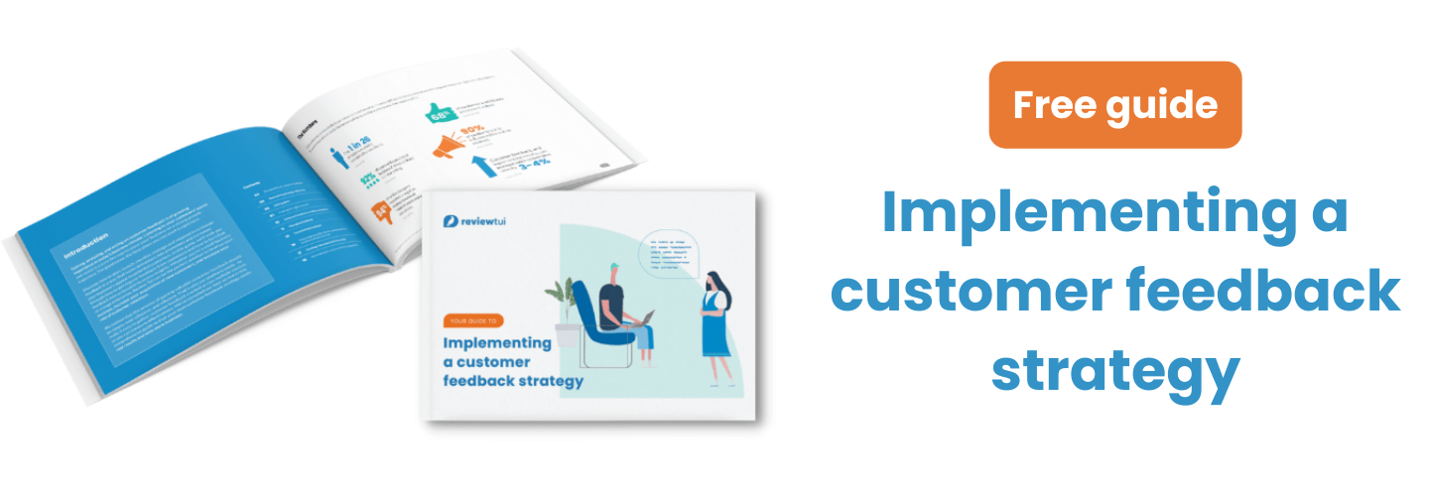What are customer feedback tools?
The right tools make it easy to connect with your customers and identify their needs. But how can you decide which strategy and channel are right for your business?
In this article, we outline the various customer feedback tools available and how you can utilise them in your business. These helpful tips will help you to implement a customer feedback strategy that will drive growth and improve customer satisfaction.
The purpose of customer feedback tools
The purpose of a customer feedback tool is to gather insights and opinions from customers. The findings can then be leveraged to improve your products, services, and customer experiences:
- Enhance the customer experience
- Track customer satisfaction
- Improve your product or service
- Increase customer retention
- Build strong customer relationships
- Make informed decisions
Customer feedback tools come in various forms, such as surveys, polls, rating systems, or customer reviews. The resulting data provides valuable information directly from your customers, including preferences, pain points, and ideas for optimisation. This way, your business can identify areas for growth and make data-driven decisions to enhance its offerings.
Offline customer feedback tools
Sometimes it’s wise to opt for the tried and tested methods of pen and paper, or even a person-to-person interview. The following customer feedback collection methods are based offline:
Mail-in feedback forms
Mail-in feedback forms are a traditional feedback method in which a printed form is posted to each customer, accompanied by a pre-paid return envelope. Customers then fill out the form with their opinions and send it back.
Key attributes:
- Considered responses
- Slow collection process
- Requires manual data calculations
- Difficult to follow up with customers
- No digital records
- Low response rates
- Low costs
Telephone questionnaire
With a telephone questionnaire, a company representative will call a customer and ask a series of questions about their experience. This allows for real-time, personalised conversations, including follow-up questions and clarification.
Key attributes:
- Human connection
- Allows follow-up questions
- Recorded and analysed
- Reaches a broad demographic
- Requires time from employees
In-person surveys
These surveys are conducted by a trained representative, who approaches a customer and asks them questions face-to-face. This allows for real-time interaction and can also help to build stronger relationships with customers. However, they can be time-consuming and may have a higher cost of implementation.
Key attributes:
- Human connection
- Allows follow-up questions
- High implementation cost
- Cannot be recorded
- Requires a lot of time from employees
Feedback boxes
Physical feedback boxes are placed in strategic locations where customers can drop in written feedback. These boxes provide a simple and accessible way for customers to share their thoughts and opinions, usually on a form with prompts.
Key attributes:
- Low cost and convenient
- No human connection
- Requires manual data calculations
- Low response rates
POS feedback kiosk
These interactive touchscreens are placed in stores or customer service centres for customers to provide real-time feedback. Point of Sale (POS) kiosks can also be customised to feature promotions and other interactive elements.
Key attributes:
- Quick and convenient
- Real-time feedback
- Higher customer engagement
- Easy to analyse
- Surveys can be customised
- High cost
Online customer feedback tools
To get the most out of your customer feedback, you should be taking advantage of all the powerful digital technologies at your disposal. The following customer feedback collection methods are based online:
Customer satisfaction survey (CSAT)
Customer Satisfaction surveys ask customers to rate their level of satisfaction with a product or service on a scale, such as 1 to 5. This provides quick and actionable insights into customer satisfaction levels at certain points in the buyer’s journey. Customer Satisfaction surveys can be conducted online, via email, or over the phone, making them accessible to a broad range of customers. The data can be easily analysed and tracked over time.
Key attributes:
- Provides a trackable metric
- Efficient and cost-effective
- Actionable insights
- Adaptable for distribution via websites, emails, or apps
- Easy to customise
QR code-enabled surveys
By placing QR codes on your products, in store, or on customer receipts, you can gather relevant feedback from customers in the moment. Customers can easily scan the QR code with their smartphone, directing them to an online survey. This method offers the advantage of immediate feedback, as customers can complete the survey at the point of interaction with the product or service.
Key attributes:
- Real-time feedback
- Use of CSAT and CES metrics
- Simple and convenient
- Low cost
- Requires access to a smartphone
Email surveys
With an email survey, an invite link is sent to customers in an email that redirects them to an online survey. This is an efficient way to target people at strategic moments in the customer experience, such as after an online order or customer service interaction.
Key attributes:
- Efficient and cost-effective
- Use of CSAT and CES metrics
- Easy to analyse and track results
- Targeted responses
Website pop-up
A website pop-up survey is an online survey that appears as a pop-up window on your website. They typically appear in response to a specific trigger, such as reaching the end of a page, clicking on a certain button, or attempting to leave the site. Pop-up surveys allow you to gather immediate and direct feedback from website visitors while they are still on the site. The results can be analysed in real-time to identify trends and patterns.
Key attributes:
- Real-time feedback
- Efficient
- Use of CSAT and CES metrics
- Targeted responses
- Easy to customise
- Technically advanced implementation
Website live chat
A live chat function on your website is typically displayed as a small chat box where customers can type in their questions or concerns. Similarly to website pop-ups, this tool allows users to share their feedback in real time while they use your website. Additionally, the chatbot or assigned employee will then respond with support and advice for the customer, creating a sense of human connection.
Key attributes:
- Real-time feedback
- Efficient
- Use of CSAT and CES metrics
- Targeted responses
- Easy to customise
Customer feedback strategy
Organizing customer feedback in a systematic manner is crucial for effective management. The key principles of successful feedback management include:
Key attributes:
- Maintain consistency.
- Cater to users’ communication preferences.
- Implement online and offline feedback methods.
- Make surveys concise and engaging.
- Use quantifiable metrics.
- Use automation and analytics.
Using a Customer Feedback Management (CFM) tool can simplify the process. Look for a CFM that integrates all the necessary features, works seamlessly with your existing tools, and offers flexible survey options. The ultimate goal is to make the feedback process effortless for your customers.
At Review Tui, our CFM software features HubSpot integration, campaign links, valuable metrics, and automatic analytics to simplify the feedback management process. To learn more about the platform and be the first to hear about our updates, sign up for the waitlist.



